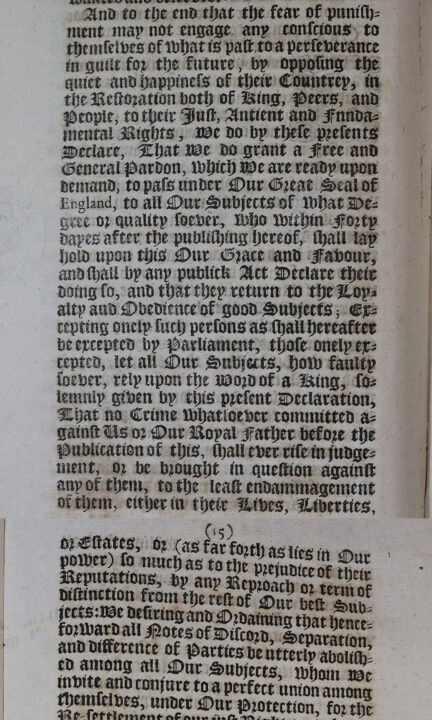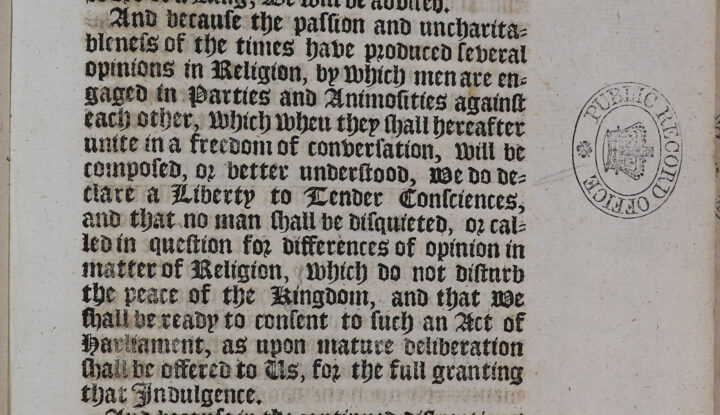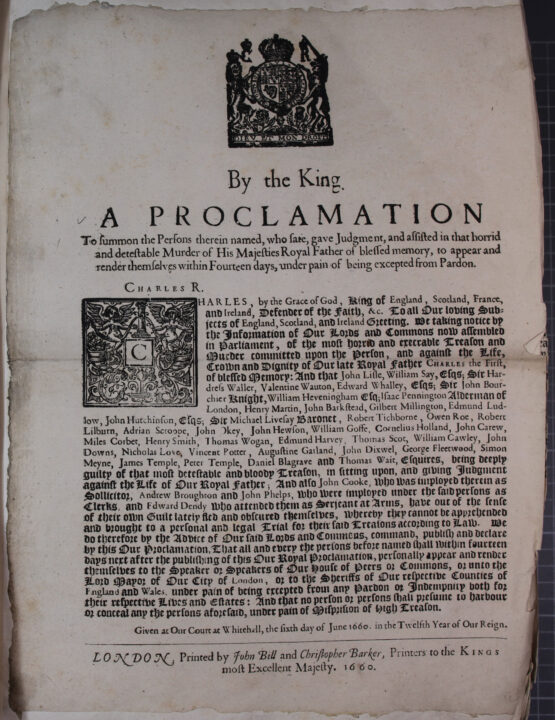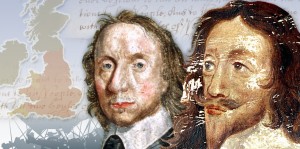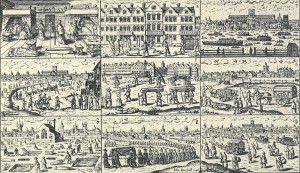
State Papers: The Restoration of the Monarchy.
We hope you enjoyed watching our Education Service video with Neil Johnson, Early Modern Records Specialist looking at records from the State Papers. This video focusses on documents relating to how Charles II secured his restoration to the throne in 1660, Catalogue ref: SP18/221.
Now try and answer the following questions:
- What type of information is held in the early modern period of the State Papers?
- What period does the State Papers cover, before the government departments of Foreign Office and Home Office were created?
- Why does The National Archives hold these records?
In terms of the context for the Restoration of Charles II:
- Why did the Cromwellian Protectorate collapse in 1559?
- What was the role of General George Monck in the Restoration 1660?
Document 1: Declaration at Breda
Extract from the Declaration at Breda’, proposals made by Charles Stuart to Parliament, the Fleet, and the City of London, April 1660, Catalogue ref: SP18/221.
Charles made the Declaration at Breda, in the Netherlands a strict Protestant country. He declared his wish for a ‘general amnesty’’, ‘liberty of conscience’, fair settlement of land disputes, and full payment of arrears to the army. The source extracts 1 & 2 shown here refer to the first two aspects of the Declaration at Breda.
Tasks
- Why do you think some people feared the restoration of the monarchy?
- How did Charles II attempt to reduce these fears in this extract?
- How does Charles II use language to convince people of a peaceful restoration?
- What does the Declaration infer about Charles’ skills as a politician?
- Find out if was significant that Charles II made this declaration from Breda in the Netherlands.
Transcript
…
And to the end that the fear of punishment may not engage any, conscious to themselves of what is past, to a perseverance in guilt for the future, by opposing the quiet and happiness of their country, in the restoration of King, Peers and people to their just, ancient and fundamental rights, we do, by these presents, declare, that we do grant a free and general pardon, which we are ready, upon demand, to pass under our Great Seal of England, to all our subjects, of what degree or quality so ever, who, within forty days after the publishing hereof, shall lay hold upon this our grace and favour, and shall, by any public act, declare their doing so, and that they return to the loyalty and obedience of good subjects; excepting only such persons as shall hereafter be excepted by Parliament, those only to be excepted. Let all our subjects, how faulty so ever, rely upon the word of a King, solemnly given by this present declaration, that no crime whatsoever, committed against us or our royal father before the publication of this, shall ever rise in judgment, or be brought in question, against any of them, to the least endamagement [harm] of them, either in their lives, liberties or estates or (as far forth as lies in our power) so much as to the prejudice of their reputations, by any reproach or term of distinction from the rest of our best subjects; we desiring and ordaining that henceforth all notes of discord, separation and difference of parties be utterly abolished among all our subjects, whom we invite and conjure to a perfect union among themselves under our protection…
Document 2: Declaration of Breda
Extract from the proposals made by Charles Stuart to Parliament, the Fleet, and the City of London. The document was known as the King’s ‘Declaration at Breda’, April 1660, Catalogue ref: SP18/221.
Charles made the Declaration at Breda, in the Netherlands a strict Protestant country. He declared his wish for a ‘general amnesty’’, ‘liberty of conscience’, fair settlement of land disputes, and full payment of arrears to the army. The source extracts 1 & 2 shown here refer to the first two aspects of the Declaration at Breda.
Tasks
- What problems concerning religion in the country does the extract refer to?
- How does Charles II intend to treat matters of religious difference?
- How will this approach ease the restoration of the monarchy?
Transcript
…
And because the passion and uncharitableness of the times have produced several opinions in religion, by which men are engaged in parties and animosities against each other (which, when they shall hereafter unite in a freedom of conversation, will be composed or better understood), we do declare a liberty to tender consciences, and that no man shall be disquieted or called in question for differences of opinion in matter of religion, which do not disturb the peace of the kingdom; and that we shall be ready to consent to such an Act of Parliament, as, upon mature deliberation, shall be offered to us, for the full granting that indulgence.
…
Document 3: Proclamation
A printed proclamation from Charles II summoning to trial and punishment all those involved in the trial and sentencing of his father Charles I dated 6 June 1660, Catalogue ref: SP 45/11
On 8 May 1660, the Convention Parliament proclaimed that King Charles II had been the lawful monarch since the execution of Charles I in January 1649. Charles arrived in London on May 29, and was crowned king at Westminster Abbey on April 23, 1661. Many Royalist exiles returned. An act of General Pardon, Indemnity and Oblivion, became law in August 1660 and pardoned any previous treason against the Crown except that committed by those present at the trial of Charles I and responsible for his death.
Tasks
- Why has Charles II issued and ordered the publication of this proclamation?
- How does Charles II use language to justify his restoration as king?
- What does the document infer about the relationship between Crown and Parliament?
- Does the document reveal anything about public attitudes to regicide at the time?
- What does the document suggest anything about crime or punishment in the 1660s? Explain your answer.
Transcript
By the King
A PROCLAMATION
To summon the Persons therein named, who sate, gave judgement, and assisted in that horrid and detestable Murder of His Majesty’s Royal Father and blessed memory, to appear and render themselves within Fourteen days, under pain of being excepted from Pardon.
Charles R. [Rex]
Charles, by the Grace of God, King of England, Scotland, France, and Ireland, Defender of the Faith etc. To all our loving subjects of England, Scotland and Ireland Greeting. We taking notice by the Information of Our Lords and Commons now assembled in Parliament, of the most horrid and execrable [appalling] Treason and Murder committed on the Person, and against the Life, Crown and Dignity of Our Late Royal father Charles the First of Blessed Memory: And that……
[list of names follows]…
Figures being deeply guilty of that most detestable and bloody treason in sitting upon and giving Judgment against the Life of Our Royal father; And also John Cooke, who has employed therein as solicitor, Andrew Broughton and John Phelps, who were employed under the said persons as clerks and Edward Dendy, who attended them as Sergeant at Arms, have out the sense of their own guilt latterly fled and obscured themselves, whereby they cannot be apprehended and brought to a personal and legal Trial for their said Treasons according to Law. We do therefore by the Advice of Our said Lords and Commons, command, public and declare by this Our Proclamation, that all and every the persons before named shall within fourteen days of this Our Royal Proclamation, personally appear and tender themselves to the Speaker or Speakers of our House of Peers and Commons, or unto the Lord Mayor of Our City of London, or to the Sheriffs of Our respective Counties of England and Wales under pain of being excepted from any Pardon or Indemnity both for their respective Lives and Estates: And that no person or persons shall presume to harbour or conceal any the persons aforesaid , under pain of high Treason.
Given at Our Court at Whitehall, the sixth day of June 1660 in the Twelfth Year of our Reign.
LONDON Printed by John Bill and Christopher Barker, Printers to the KINGS most Excellent Majesty, 1660
Connections to Curriculum
Key stage 4
AQA GCSE Restoration England, 1660–1685
Key stage 5
AQA GCE. Monarchy restored and restrained: Britain, 1649–1702
Edexcel GCE Britain, 1625–1701: conflict, revolution, and settlement.
OCR GCE: The Execution of Charles I and the Interregnum 1646–1660: The Restoration of Charles II
Key stage 3
The Restoration, ‘Glorious Revolution’ and power of Parliament
External links
- Read this National Archives blog on the Restoration of Charles II
- Read this History of Parliament blog on the Restoration
- See more sources from the Royal Collections Trust
- Samuel Pepys entry in his diary about the Restoration
Related Resources
Civil War – https://www.nationalarchives.gov.uk/education/resources/civil-war/
Great Fire of London: how London changed – https://www.nationalarchives.gov.uk/education/resources/fire-of-london/
Great Plague of 1665-1666 – https://www.nationalarchives.gov.uk/education/resources/great-plague/
Samuel Pepys – https://www.nationalarchives.gov.uk/education/resources/samuel-pepys-will/
